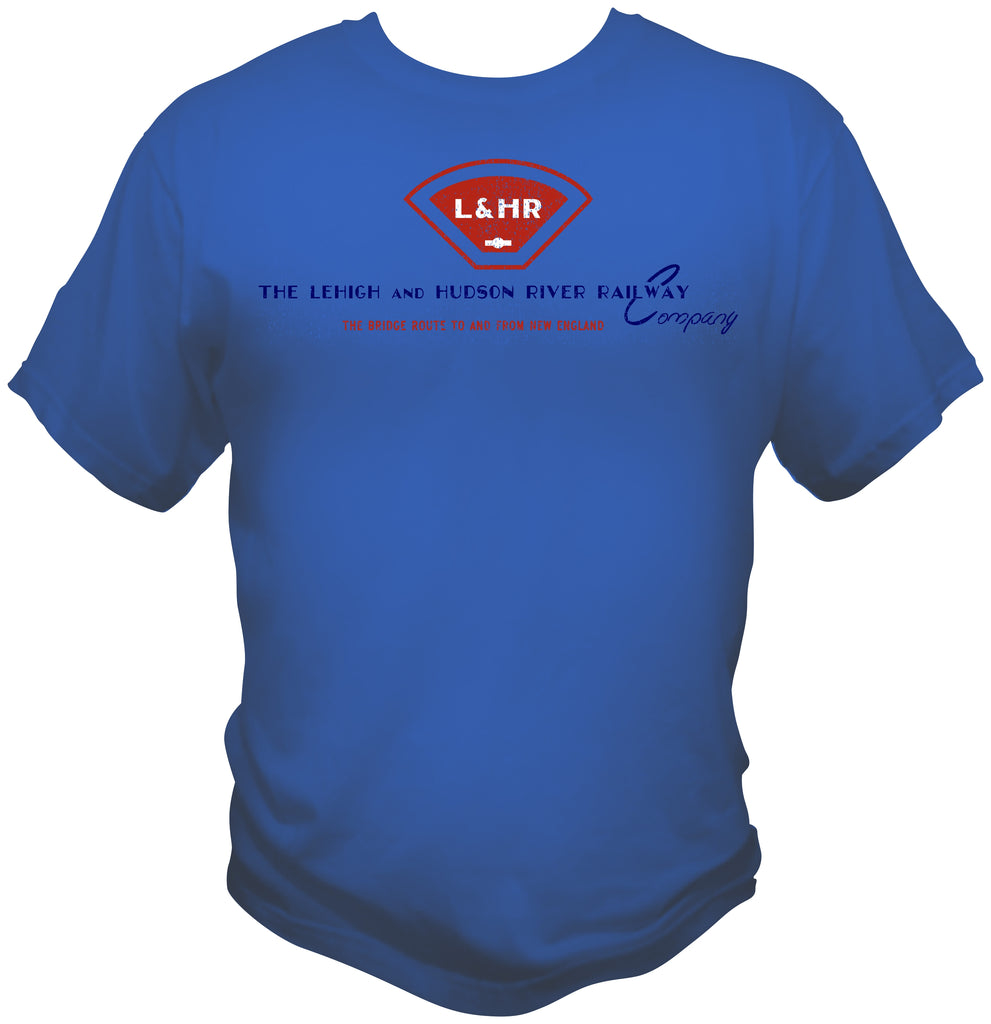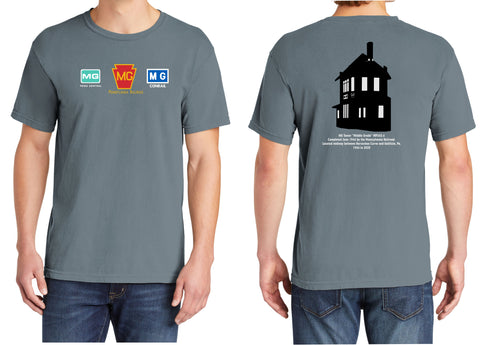
Lehigh & Hudson Railway Letterhead Logo Faded Glory Shirt
Lehigh & Hudson Railway Letterhead Logo Faded Glory Shirt
- Printed on Front
- 100% Cotton
- Shirt Color - L&HR Royal Caribe 100% cotton Comfort Color
The Warwick Valley Railroad was organized March 8, 1860 as a branch of the New York and Erie Rail Road, branching from it at Greycourt southwest to Warwick, New York. It opened in 1862 and was operated by the Erie.
The Pequest and Wallkill Railroad was chartered by 1870 to build an extension in New Jersey, running from Belvidere on the Delaware River and Belvidere Delaware Railroad northeast to the New York state line. The Lehigh and Hudson River Railroad was chartered later as a competitor, planning to build from Belvidere to McAfee, with the Wawayanda Railroad running the rest of the way to the state line. In April/May 1881, the three companies merged to form a new Lehigh and Hudson River Railroad and on April 1, 1882, the Warwick Valley Railroad joined, forming the Lehigh and Hudson River Railway (L&HR).
Train wreck near the Newburgh Branch, at the Greycourt, New York water tower, involving Engines #24 & 89, c. 1880.
In the meantime, the Sussex Railroad had built a branch from Hamburg to South Vernon (McAfee); the L&HR bought this around 1881. The Warwick Valley Railroad had built an extension southwest to McAfee in March 1880, and the full line opened August 14, 1882, connecting Belvidere, New Jersey to Greycourt, New York.
The Orange County Railroad was chartered on November 28, 1888 and opened the following year, extending the line northeast from Greycourt to Maybrook. At Maybrook, the line junctioned with the Central New England Railway, continuing east via the Poughkeepsie Bridge over the Hudson River to New England. Trackage rights were obtained over a short piece of the New York, Ontario and Western Railway from the junction at Burnside west to the major junction at Campbell Hall.
The South Easton and Phillipsburg Railroad of New Jersey, and the South Easton and Phillipsburg Railroad of Pennsylvania was organized on July 25, 1889 to build a bridge over the Delaware River between Easton, Pennsylvania and Phillipsburg, New Jersey. The former built 460' on the New Jersey side, while the latter built 850' on the Pennsylvania side. Bridge construction began on November 19, 1889, and concluded the following year on October 2.[1] "The South Easton and Phillipsburg Railroad of New Jersey and South Easton and Phillipsburg of Pennsylvania were consolidated with the Lehigh and Hudson River Railway on April 2, 1912." [2][3] Subsequently, the L&HR obtained trackage rights over 13 miles of the Pennsylvania Railroad's (PRR) Belvidere Delaware Railroad between Phillipsburg and Belvidere;once the bridge was completed, the L&HR had a continuous line from Maybrook to Easton. At Easton, an interchange could be made with the Central Railroad of New Jersey and Lehigh Valley Railroad, while interchange with the PRR was at Phillipsburg. In 1908, L&HR lost the trackage rights from Phillipsburg to Belvidere as PRR took them back.[citation needed]
The L&HR eventually obtained trackage rights over the Delaware, Lackawanna and Western Railroad's (DL&W) Sussex Railroad from the junction at Andover south to Port Morris, where it interchanged with the main line of the DL&W.
The Mine Hill Railroad was the only branch built. It ran south from a junction at Franklin, New Jersey to the mines of the New Jersey Zinc Company at Sterling Hill, New Jersey.
Revenue freight traffic, in millions of net ton-miles
Year Traffic
1925 373
1933 183
1944 418
1960 274
1967 404
Source: ICC annual reports
From October 1912 until January 1916, the L&HR hosted the PRR's Federal Express passenger trains on the Poughkeepsie Bridge Route between Phillipsburg and Maybrook. With the completion of the Hell Gate Bridge in New York City on September 9, 1917, the Federal Express resumed service via Penn Station and the New Haven Line direct.[1] At its peak, L&HR stretched 86 miles between Easton and Maybrook, acting as a bridge line and hauling anthracite coal from a number of mines along its system.[citation needed]
Bankruptcy[edit]
The L&HR filed for Chapter 77 bankruptcy on April 19, 1972, partly due to Penn Central's decision to operate over other routes in order to avoid the aging Poughkeepsie Bridge.[4]
Post-bankruptcy, the L&HR continued to operate a nocturnal daily freight. During the mid-1970s, the LH&R became part of a proposal to run "Bunny Ski Trains" between Hoboken, New Jersey and the Playboy Resort (Great Gorge) in Vernon, New Jersey. The proposed service, which would have run on weekends during the winter, would have retrieved passengers westbound along the Erie Lackawanna Railway's (EL) Morristown Line to Netcong, New Jersey, then run along a short section of the remaining Sussex Branch to Andover Junction in Andover, New Jersey, and then northbound along the L&HR to the Playboy Club. The service would have utilized EL's new commuter consists, but was met with stiff opposition from EL management, which was anticipating a merger with other northeastern US railroads and did not want to enter into a venture that it viewed as a potential money-loser. The Bunny Ski Train remained a viable proposal until the remaining vestige of the Sussex Branch was removed in July 1977, after it became clear that it was no longer needed as a connector to the LH&R.
The L&HR running under the abandoned Lackawanna Cut-Off near Tranquility, New Jersey, circa 1989. By this point, the L&HR line had been abandoned, and trackage removal occurred when land ownership transferred from Conrail to land developer Gerard Turco
As such, in 1976 the L&HR was merged into Conrail. Subsequently, the section between Belvidere, New Jersey and Sparta, New Jersey (Sparta Junction) was abandoned. The tracks, however, remained in place until approximately 1988, when the right-of-way between these two points was acquired by land developer Gerald Turco from Conrail. Turco had also acquired most of the Lackawanna Cut-Off as part of the same deal. Conrail removed the tracks south of Sparta Junction; however, the section north of that point was already being considered by the New York, Susquehanna & Western (NYS&W) as part of a combined regional freight route with Norfolk Southern Railway (NS). The line from Warwick to Campbell Hall, New York is currently leased to the Middletown and New Jersey Railroad.
In New Jersey, the NYS&W owns the L&HR line north of Sparta to the state line. North of the state line, it is owned by NS which had acquired the line during the breakup of Conrail. Both portions of the line are leased to and operated by the Middletown and New Jersey Railroad.[5]
*Image is a representation and may not be exact.




